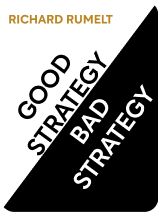

This article is an excerpt from the Shortform book guide to "Good Strategy Bad Strategy" by Richard Rumelt. Shortform has the world's best summaries and analyses of books you should be reading.
Like this article? Sign up for a free trial here .
What exactly is strategic management? How do businesses develop strategies? What goes into a business strategy?
In the most basic terms, strategic management involves setting objectives and devising strategies to attain them. According to Richard P. Rumelt, one of the most influential thinkers and strategic management and strategy design, a good organizational strategy must have a “kernel”—an underlying structure consisting of three components: 1) diagnosis, 2) guiding policy, and 3) action plan.
Read more about the two primary truths about an organizational strategy and the kernel at the heart of any good strategy.
What Makes a Good Organizational Strategy?
According to Richard P. Rumelt, an acclaimed expert on strategic management and strategy design, there are two primary truths about an organizational strategy:
- Just having a strategy is a good strategy.
- A good strategy uses hidden strengths.
Just Having a Strategy Is a Strategy
The first truth about strategy is that remarkably, simply having a strategy is a strategy. Most organizations operate reactively to challenges on a day-to-day basis, having only a fuzzy outline of long-term goals that they mistakenly call “strategy.” Often, leaders find it difficult to articulate their organization’s strategy beyond vague plans like “make alliances” or “set strategic goals.”
Interestingly, leaders can often identify the strategy of their competitors more easily than their own. This is especially true if their competitors are market leaders. They can see that a window of opportunity opened and their competitors took advantage of it better than anyone else. They are thus able to recognize that good strategy means moving quickly to take strong positions in new opportunities, yet they don’t adopt this strategy themselves.
Thus, when an organization does have a well-thought-out and specific strategy, it has an advantage over its competitors simply because it is better prepared for the challenges that face all rivals in an industry. A company with coherent and coordinated plans and policies is positioned to take advantage of opportunities other companies may not have even been looking out for.
Case Study: Apple
Apple’s turnaround when Steve Jobs returned to the company as CEO illustrates the advantage of having a strategy. By 1997, Apple was heading for collapse. The release of Microsoft’s Windows 95 operating system in 1995 had eaten up so much market share that then-CEO Gil Amelio was attempting to keep Apple alive by cutting staff, reorganizing the company’s many products, and adding unrelated internet services. He was floundering, in other words, for a coherent strategy and was instead just trying different things to see what might work. Industry watchers expected the company to be sold to IBM or to find their direction by specializing in a niche; for example, by investing in K-12 education.
Steve Jobs came back to the company as CEO in September 1997 when Apple was just two months from bankruptcy. Within a year he had turned the company around by instituting a basic, focused strategy: He cut Apple back to a simplified, small, strong core and eliminated anything that didn’t serve that core. In doing so, he identified the fundamental problem of the company—it was unfocused—and then developed a coordinated set of actions to address that problem:
- He simplified the company’s product line, eliminating fourteen of its fifteen desktop models, all portable and handheld devices except one, and all printers and other peripheral items.
- He let many development engineers go and he halted much software development. Importantly, he didn’t simply reduce staff across all departments; his cuts were specifically tailored to serve his strategy of reducing to and strengthening the company’s core.
- He replaced distributors and most of the company’s retailers with a web store that sold directly to customers.
- He did not announce profit goals or grand visions. He focused on actionable objectives rather than lofty, long-term ambitions.
Jobs was thus able to turn the company around by instituting a clear, explicit strategy instead of merely, as his predecessor had done, trying a bit of this and a bit of that. The company had the same resources before introducing a strategy as it did after, but the clear, focused direction the strategy provided proved the difference between success and failure.
Case Study: Desert Storm
The U.S. retaking of Kuwait in 1991 provides another great example of where having a strategy makes a difference. When the U.S. set out to retake Kuwait after it had been taken over by the Iraqi Republican Guard, everyone—including the news media, European nations, and Saddam Hussein’s forces—expected them to attack in a tried-and-true way of meeting the enemy head-on at the frontlines. Because Iraqi forces had been setting up their defenses for months, observers expected a strong resistance, and many expected the operation to take over a week and cost tens of thousands of American lives.
However, the commanding officer, General Norman Schwarzkopf, had a strategy. He openly stationed Marines in the south as if they were going to attack, but then maneuvered other troops surreptitiously up to the north through empty deserts so that they’d be positioned to attack from the back unexpectedly. The strategy was so successful that the ground war lasted just 100 hours. It was successful because its very existence was unexpected.
In this case, the advantage was that the strategy was unexpected by the competition, the Iraqi forces. The strategy itself wasn’t novel—in fact, it was publicly available as “Plan A” in military handbooks—but because the U.S. wasn’t expected to have any strategy other than the obvious “fight hard,” it was unexpected. Consequently, it led to quick victory.
A Good Strategy Uses Hidden Strengths
The second truth about good strategy is that above all else, it leverages your strengths against your competitor’s weaknesses. In doing so, it is often most effective when it harnesses the element of surprise to leverage unexpected strengths against unknown weaknesses. When good strategy reveals strengths that were previously hidden, the competition does not have prepared defenses against them and the strengths are all the more effective.
For example, in the story of David versus Goliath, a shepherd boy faced a warrior in a fight to the death. They each had known strengths: Goliath was strong, experienced, and enormous; David was brave. David had known weaknesses: He was small and inexperienced in battle. Goliath had no known weaknesses. But David felled the giant with a well-aimed rock slingshotted at his forehead—the only part of his body unprotected by armor. David thus revealed a hidden strength in himself (his slingshot skills) as well as an overlooked weakness in his opponent (his unprotected forehead). Consequently, though the story is often told as an example of weakness over strength, it is better understood as an illustration of excellent strategy pitting specific unexpected strength against targeted unknown weakness.
Case Study: Walmart
The success of Walmart illustrates the power of finding and exploiting a rival’s hidden weakness with an unexpected strength of your own. In the 1970s and 1980s, Walmart was the David to retail’s Goliath: Kmart. Walmart had a known weakness (being small-scale) and KMart had known strengths (being large and well-established) that led industry watchers to assume that KMart’s dominance of the market would continue unimpeded. However, Walmart was able to identify two key weaknesses in their competitor that had not, until then, seemed like weaknesses:
- Because KMart was large and well-established, it would be difficult for the company to structurally reorganize.
- Because KMart operated with a decentralized retailing structure, allowing each store to respond to the preferences of its location with personalized product lines, vendors, and prices, it would not be able to effectively adopt a network structure.
While conventional retailing wisdom of the era said that decentralization added strength to a business thanks to the flexibility it could provide, Walmart broke with that wisdom by building a centralized network that anchored its various locations around a centralized hub. It recognized the hidden weakness of decentralization—the higher costs of uncoordinated efforts and the learning opportunities lost when data is not internally shared—and it built its stores to each be part of a larger whole, sharing distribution logistics, vendors, data, and policies. It essentially reimagined itself as one large company with many interrelated pieces, rather than many unrelated parts making up a larger conglomeration.
In doing so, Walmart exploited the fact that with its entrenched structure, KMart would not be able to quickly replicate a networked business model. To reap the benefits of a network, a company needs to adopt the entire structure; incorporating elements of it piecemeal won’t bring benefits, since the strength of a network lies in its ability to integrate all its various parts. Therefore, when KMart tried to adopt some of Walmart’s policies, it didn’t see the same results.
For example, both companies introduced point-of-sale barcodes around the same time. However, because Walmart’s codes fed into an integrated data system that helped determine inventory distribution, while KMart’s only eliminated the need to use physical price stickers, KMart’s barcodes didn’t add to the efficiency of their whole system in the same way that Walmart’s did.
Case Study: U.S. Military Versus the Soviet Union
The successful strategy of the U.S. military in managing the threat posed by the Soviet Union provides an excellent example of what can happen when you resist playing a game based on your opponent’s strength, and instead start framing your conflict around their overlooked weakness.
In the early 1970s, the Pentagon’s strategy of Soviet containment amounted to a pattern of buying weapons to counter perceived Soviet threats. This strategy centered on responding to Soviet strengths, and resulted in an unfocused cycle of reactive weapons purchases. It allowed the military to prepare for short-term challenges but didn’t provide a plan for handling the Soviet Union in the long run.
In 1976, a new strategy was developed that turned the previous thinking on its head by centering a plan of action around Soviet weaknesses. Its key insight was that the Soviets’ primary weakness was their limited budget. Exploiting this weakness by forcing the Soviets to spend more than they could sustainably afford would eventually lead to their downfall. Specifically, this meant investing in technologies that the Soviets would feel compelled to counter but were extremely expensive, and which would not significantly benefit Soviet offensive capabilities if they did counter them.
For example, the U.S. increased the accuracy of its missiles and the quietness of its submarines. The Soviets matched those capabilities, even though those developments didn’t particularly increase the threat to American lives. By 1990, as a result of these types of ongoing military expenditures, the USSR was going broke. It couldn’t keep up with increased American technological superiority, and it collapsed in 1991.
Thus, the American strategy was successful: Identify your relative advantage over your competition, then use it to impose outsized costs, which will make it difficult for them to compete with you.
The Kernel of Good Strategy
At the core of good strategy lies a basic underlying structure that unites thought and action called the “kernel.” The kernel does not include convoluted language, visions, goals, or timelines. Instead, it has three elements:
- Diagnosis: a definition of the challenge and the most critical aspect of it.
- Guiding policy: a clearly outlined approach to cope with the challenge.
- Action plan: a set of actions that work with each other to accomplish the guiding policy.
Each of these elements is explored in the following sections.
1. Diagnosis
A diagnosis asks, “What’s going on here?” It examines a challenging situation, looking for patterns, comparing it to past situations, and identifying which areas need the most attention. In doing so, a diagnosis aims to define the primary problem facing an organization.
It’s important to focus on just one or two primary problems; focusing on too many means spreading your resources thin. Do your best to judge which problem is the keystone problem—the one that will affect all the others—and start there.
Sometimes it’s hard to come up with a diagnosis. Problems are often ill-structured, that is, they are caused by a variety of different factors and it can be difficult to judge which of those is the most critical. Getting it wrong can send your strategy in the wrong direction. Sometimes different people will have different views on what the correct diagnosis of a problem is. The challenge for a leader is to see when an outsider’s diagnosis is incorrect and to look for a better diagnosis instead.
Case Study: IBM
In 1993, IBM was in decline. Its strategy of offering complete and integrated computing solutions to companies and government agencies was losing ground to the increasingly fragmented landscape driven by microprocessors, and it couldn’t differentiate its desktop computers from the many competitors entering the market. The company needed a new strategy.
Though most industry watchers decided the problem was that the company was too integrated, and thus the solution was to break it up and sell off various pieces, the new CEO, Lou Gerstner, disagreed. He decided that the problem was not that the company was too integrated but that it was failing to take full advantage of the opportunities such integration offered: The primary challenge was a lack of internal coordination.
This new diagnosis was not a strategy in and of itself, but it allowed the company to develop a new guiding policy leveraging the fact that IBM was uniquely integrated and could offer broad computing solutions rather than hardware platforms.
2. Guiding Policy
A guiding policy is a clearly outlined approach to coping with the challenges identified by the diagnosis. It focuses an organization’s particular advantages toward targeted objectives to meet those challenges, steering the organization away from tangential or ineffective actions. In the example above with IBM, this meant leveraging its position as a uniquely integrated company.
An excellent example of good guiding policy is Wells Fargo’s. The company’s corporate vision aims to satisfy all of its customers’ financial needs. It supports this ambitious goal with a specific guiding policy of cross-selling to take advantage of network effects. The guiding policy fosters loyalty among its customers by providing them with a wide range of financial products, which helps to achieve the company’s overarching goal.
3. Action Plan
Many people develop a diagnosis and a guiding policy and stop there, thinking their strategic plan is complete. But the kernel also needs a focused action plan to harness organizational energy.
An action plan coordinates a variety of operations to carry out the guiding policy, defining resources, policies, and movements that support one another. For example, a company with a simple and clear competitive advantage like, say, being a low-cost retailer, will have interrelated policies affecting sales, marketing, distribution, and design that will mutually support each other in order to keep prices low.
When action plans are not coherent, it’s because they either have internal conflicts or they are pursuing too many challenges. An example of an action plan with internal conflicts was when Ford purchased a number of high-end automotive brands, including Jaguar and Volvo. Ford’s overall guiding policy for the company in general was “economies of scale,” meaning their action plans centered around large, bulk purchases and manufacturing processes that could be shared among brands. However, the top-shelf brands they acquired each needed different action plans, and the company had trouble incorporating the new business units into their existing model. Jaguar owners didn’t want “snazzy Volvos” and Volvo buyers didn’t want “safer Jaguars.” The sets of conflicting action plans needed proved unresolvable, and Ford ended up selling off its luxury car brands in the 2000s.
Action Plans Are Centralized
Action plans are centralized; they are coordinated plans overseen by upper management that guide all divisions and departments within an organization. Sometimes people object to the centralized nature of action plans. After all, decentralization has been proven effective in many situations. For example, sometimes decentralization allows a company to respond to local customer preferences to maximize profits, such as 7-Eleven, which tailors its beverage offerings regionally.
However, centralization has advantages over decentralization. When the costs or benefits of certain decisions are shouldered unevenly among departments, only a centralized set of directives can ensure that everyone signs on. Sometimes, too, the benefits of a strategy will only accrue if the strategy is executed wholesale. This recalls our earlier example of Walmart versus KMart, where the benefits of, say, the point-of-sale barcodes only happened when the company had a fully-developed data-support network behind it. A coherent action plan that integrates all policies ensures full uptake of a strategy across all divisions and departments, giving it the best chance of success.

———End of Preview———
Like what you just read? Read the rest of the world's best book summary and analysis of Richard Rumelt's "Good Strategy Bad Strategy" at Shortform .
Here's what you'll find in our full Good Strategy Bad Strategy summary :
- The essential components of good strategy and the faulty thinking behind bad strategy
- Specific and measurable techniques for designing a focused strategy for success
- How to overcome challenges and gain a competitive edge






